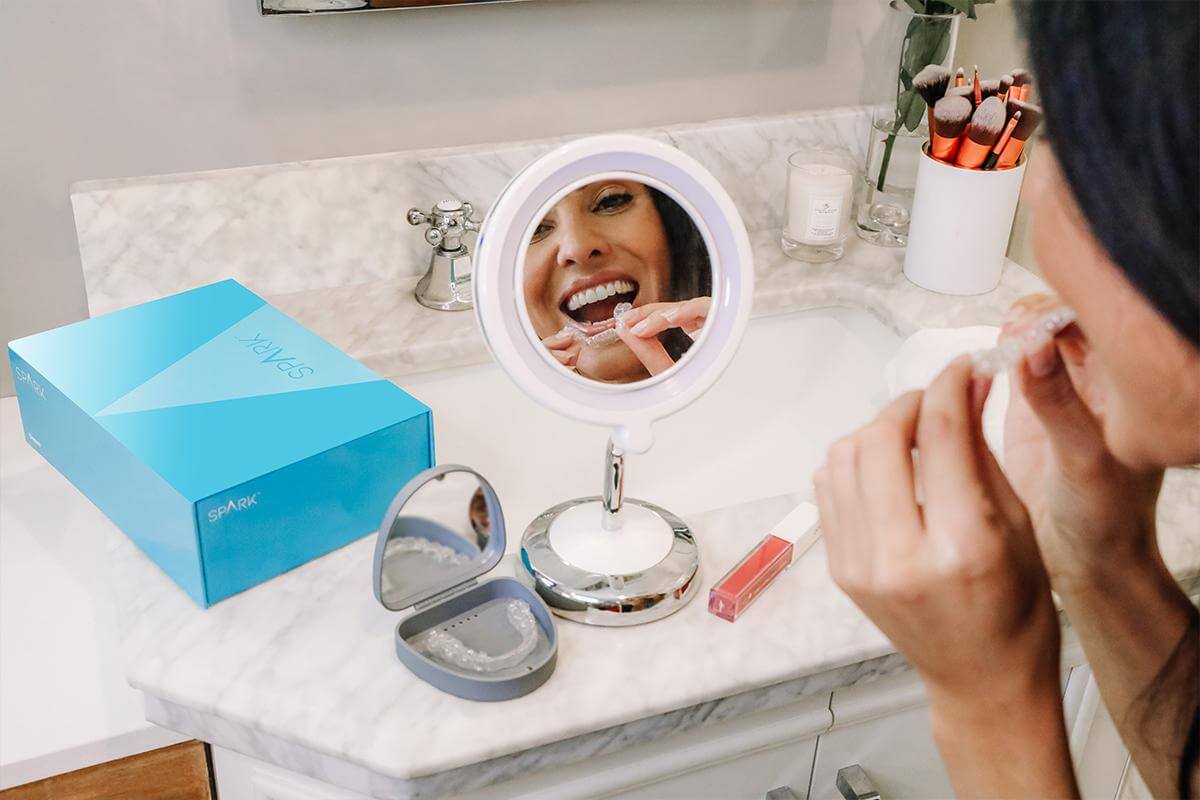About Damon Braces
When you think of straightening your teeth, braces are probably the first thing that come to mind. Braces come in metal and ceramic options and consist of wires and brackets. These brackets and wires work with elastic bands to straighten teeth. They are available to virtually anyone who wants to straighten their teeth.
While there are clear aligners available to help with alignment issues, generic braces are the most effective option. They are created to tackle even the most severe alignment issues in your mouth.
You might think that a minor misalignment is no big deal, but even if your teeth are misplaced just a little bit, you could suffer from various medical issues. Not only can you develop more plaque buildup, but you could develop gum disease, which can lead to high blood pressure, diabetes, and even cancer. Misaligned teeth can also lead to chewing issues, chronic pain, breathing issues, and infections. A crooked mouth can also lead to mental health issues, such as lowered self-esteem, anxiety, and depression.
So even if you think you have a mild case, consider a free initial consultation from Hinsdale Ortho. Braces can help improve your physical and mental health.
How Do Braces Work?
Braces move your teeth by placing pressure on them for extended periods of time. Your lower and upper jaw gradually adapts to conform to this pressure.
Braces have three main components:
- Brackets. The brackets are probably the first thing you see when you see braces. They are made from metal or tooth-colored ceramic. They are attached to each tooth with glue, cement, or a band.
- Arch wire. The arch wire is a thin metal wire that runs over each bracket. This wire has an important job, as it provides the force and pressure required to move teeth to their desired positions.
- Elastic. Also known as “O-rings,” elastics come in many colors. They are used to hold the arch wires in place and are usually changed at every appointment.
These bands are placed around the brackets to add more pressure. The archwire is adjusted periodically as your teeth move into place. The elastic bands are switched out at each orthodontist appointment and can be customized with different colors each time.
Traditional braces require two long appointments: when you put them on and when you take them off. During the course of orthodontic treatment, you’ll typically have appointments every few weeks so your orthodontist can make adjustments. You’ll also have to see your Hinsdale orthodontist if you break a bracket or wire.
Some patients may require spacers or springs. Spacers are made of rubber bands or metal rings and placed between molars. They help push your jaw forward and make room for your braces if your mouth is too tight. Coil springs may be placed on the archwire of your braces. They are placed between two teeth to add more space.
Advantages of Braces
Braces have some benefits over clear aligners, such as:
- They are more effective for severe cases.
- They use more force to push teeth into place.
- They are on the teeth 24/7, so they cannot be removed or lost.
- They can close gaps and align teeth more quickly in some cases.
- They are often cheaper.


Cost of Braces for Straight Teeth
The cost of braces can vary based on the type of braces, the severity of your case, and your location.
- Metal braces: $3,000-$7,000
- Ceramic braces: $4,000-$8,000
- Lingual braces: $8,000-$10,000
You may be able to get help paying for braces if you have health or dental insurance. Many oral health plans do partially cover children under age 18.
If your dental plan does include orthodontic coverage, keep in mind that there are likely strict limits in terms of coverage percentage and lifetime maximum. A common figure is 50% coverage with a $1500 lifetime maximum per child. Plus, keep in mind that most orthodontic coverage will not cover braces if they have already been applied to the teeth prior to the effective date of the policy. It is considered a pre-existing condition and becomes an out-of-pocket expense.
What to Know About Braces
Before meeting with your orthodontist for the first time, here are some things you should know about braces:
- There are no age restrictions. While it may be better to get braces earlier in life, you can get them as an adult. Better late than never!
- There are many types of braces. There are metal and ceramic braces, as well as Damon braces. There are also clear aligners. You have several options, so talk to your orthodontist about the option that is right for you based on your condition.
- Clean teeth are a must. Make sure your teeth clean before getting braces put on. You’ll also need to ensure you are cavity free. Once you get your braces on, you will especially need to spend extra time keeping them and your teeth clean.
- Prepare for discomfort. Braces put pressure on your teeth, so you may experience some soreness for the first few days. Eat soft foods and take pain medication as needed.
- Your treatment time will vary. Depending on your situation, you may have braces for 1-3 years. This will depend on the course of treatment and how quickly your teeth move. Your orthodontist can give you an idea of your start treatment time.
- Eat the right foods. If you wear braces, beware. Certain foods can get stuck in your brackets or cause them to break. Some foods to avoid include popcorn, chips, bubble gum, beef jerky, apples, corn on the cob, carrots, and hard or sticky candy.
- Prepare for a retainer. Once your braces come off, the next step will be a retainer. There are several types of retainers. The orthodontist will choose the right one based on your treatment plan.
Damon Clear Braces
At Hinsdale Ortho, we offer clear braces, which are also known as ceramic braces. Ceramic braces are tooth-colored, so they’re not as noticeable as generic metal braces. When paired with clear, white, or tooth-colored wires, ceramic brackets are a less obvious way to straighten your smile. So if you’re looking for something aesthetically pleasing, clear braces offer a low-profile look.
Damon clear braces are made of tooth-colored polycrystalline ceramic material. Your brackets will be practically invisible, making them a great option for older teenagers and adult patients who have cosmetic concerns.
Even though the brackets are about the same size and shape as metal braces, they’re much less noticeable. Keep in mind, though, that ceramic braces can sometimes be slightly more fragile because they are made from a different material that is more prone to cracks and chips. In addition, they are often more expensive than metal braces.
Damon Metal Braces
While there are aligners and clear braces available to straighten teeth, today’s metal braces are more effective and stronger than ever. Damon braces are not the same braces your parents had. They’re smaller and less noticeable than before. Plus, they work more quickly and efficiently to accomplish your smile goals.
Damon braces consist of advanced technology. Sleeker brackets and lighter wires make your mouth look better than ever. This also means your mouth will feel less irritated, so you’ll be happier and less sore.
Your orthodontic treatment time will vary, but expect an average of 18-22 months. Work with your Hinsdale orthodontist to develop your customized treatment plan.
Damon metal braces combine strength, durability, and affordability. Choose Damon metal braces for your alignment needs and smile with self-confidence!
Damon Braces vs. Traditional Metal Braces
So now that you know about Damon braces and traditional braces, how are they alike and how are they different? Both have the same goal of straightening teeth via the use of orthodontics. The main difference between these two types of braces is how they straighten teeth.
Traditional braces use elastics to hold wires and brackets together. These wires and brackets are on very tight, resulting in more force applied to teeth. This, in turn, causes more friction and pain, which can slow down treatment.
Another downside to traditional braces is hygiene. They tend to get dirty quickly because the materials used can easily attract bacteria. There are also small spaces between the ties and brackets, which makes it easy for food to get trapped. And if a bracket or wire breaks — which can happen often based on a patient’s diet — then it could set your treatment back by several months.
Damon Braces, on the other hand, are an innovative way to straighten teeth. Damon braces do not use ties due to their self-ligating system. This means they use a built-in system to hold the wire. The mechanism applies a lighter amount of force, allowing teeth to move more naturally. As a result, patients report feeling less discomfort.
Damon braces use a memory system that slowly moves teeth with pressure. No manual adjustments are needed, which means you need fewer office visits. What’s not to love?
Ceramic Braces
Another type of braces you may want to consider is ceramic braces. Ceramic braces are similar to metal braces, but they use clear or tooth-colored brackets. Compared to metal braces, this makes them less noticeable on your teeth, making you feel less self-conscious.
Ceramic braces can be used for severe cases of misalignment. They move more quickly than clear aligners and take 18-36 months for a straighter smile.
However, there are some downsides to keep in mind. Ceramic braces cost as much as $2,000 more than metal braces. The brackets are larger, making teeth harder to clean. They’re also less durable and move teeth more slowly than metal braces. Studies show that ceramic braces break twice as much as metal braces.
Lingual Braces
Many people delay the orthodontic process because of one main reason: the appearance of braces. Braces can be unsightly, making a person feel self-conscious. They may refuse to smile while undergoing orthodontic treatment.
Lingual braces remove this issue because they are placed behind the teeth, making them virtually invisible. Lingual braces can fix most of the issues that conventional metal braces can fix. However, those with large overbites can break these braces more easily.
Lingual braces can be more costly, though, because they require a custom fit. Plus, putting them on is a delicate, time-consuming process.
Why We Are the Best Orthodontic Treatment in Chicago
From the moment you walk into Hinsdale Ortho, we work hard to make your orthodontic experience an unforgettable one. Our kind and friendly staff members always provide courteous and prompt service. Our dentists are knowledgeable and professional, giving you the orthodontic treatment and advice you need to rock a perfect smile!
We treat patients of all ages and provide a personalized orthodontic treatment plan for everyone. We proudly serve children, teens, and adults, so bring in the whole family. We understand you’re busy and that your time is important, so we pride ourselves on providing quick, on-time appointments. We won’t keep you waiting too long!
Need more proof that we’re the best around? Check out our patient testimonials. We’ve been a trusted presence in the community for decades. We have hundreds of five-star reviews from satisfied patients. Our patients love us just as much as we love them!
Contact Hinsdale Ortho Today to Get a Great Smile
If you want to straighten your teeth the old-fashioned way, Damon clear braces and Damon metal braces are great options for those looking for straight smiles. These methods are effective for even the most severe alignment cases.
Hinsdale Ortho has been offering high-quality orthodontic treatment in a friendly, welcoming environment for more than 65 years. Our state-of-the-art technology makes us the best orthodontist around. To schedule a free consultation, call (630) 345-8589 or go online.
